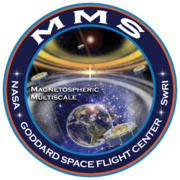Magnetospheric Multiscale Mission
 |
|
| Mission type | Magnetosphere research |
|---|---|
| Operator | NASA |
| COSPAR ID | 2015-011A, 2015-011B, 2015-011C, 2015-011D |
| SATCAT no. | 40482, 40483, 40484, 40485 |
| Website | mms.gsfc.nasa.gov |
| Mission duration | Planned: 2 years, 5.5 months Elapsed: 2 years, 5 days |
| Spacecraft properties | |
| Manufacturer | Goddard Space Flight Center |
| Launch mass | 1,360 kg (2,998 lb) |
| Dimensions | Stowed: 3.4 × 1.2 m (11 × 4 ft) Deployed: 112 × 29 m (369 × 94 ft) |
| Start of mission | |
| Launch date | 13 March 2015, 02:44 UTC |
| Rocket | Atlas V 421 |
| Launch site | Cape Canaveral SLC-41 |
| Contractor | United Launch Alliance |
| Orbital parameters | |
| Reference system | Geocentric |
| Regime | HEO |
| Perigee | 2,550 km (1,580 mi) |
| Apogee | Day phase: 70,080 km (43,550 mi) Night phase: 152,900 km (95,000 mi) |
| Inclination | 28.0° |
 |
|
The Magnetospheric Multiscale Mission (MMS) is a NASA unmanned space mission to study the Earth's magnetosphere, using four identical spacecraft flying in a tetrahedral formation. The spacecraft were launched on 13 March 2015 at 02:44 UTC. It is designed to gather information about the microphysics of magnetic reconnection, energetic particle acceleration, and turbulence, processes that occur in many astrophysical plasmas.
The mission builds upon the successes of the ESA Cluster mission, but will surpass it in spatial resolution and in temporal resolution, allowing for the first time measurements of the critical electron diffusion region, the site where magnetic reconnection occurs. Its orbit is optimized to spend extended periods in locations where reconnection is known to occur: at the dayside magnetopause, the place where the pressure from the solar wind and the planets' magnetic field are equal; and in the magnetotail, which is formed by pressure from the solar wind on a planet's magnetosphere and which can extend great distances away from its originating planet.
Magnetic reconnection in Earth's magnetosphere is one of the mechanisms responsible for the aurora, and it is important to the science of controlled nuclear fusion because it is one mechanism preventing magnetic confinement of the fusion fuel. These mechanisms are studied in outer space by the measurement of motions of matter in stellar atmospheres, like that of the Sun. Magnetic reconnection is a phenomenon in which energy may be efficiently transferred from a magnetic field to the motion of charged particles.
...
Wikipedia
